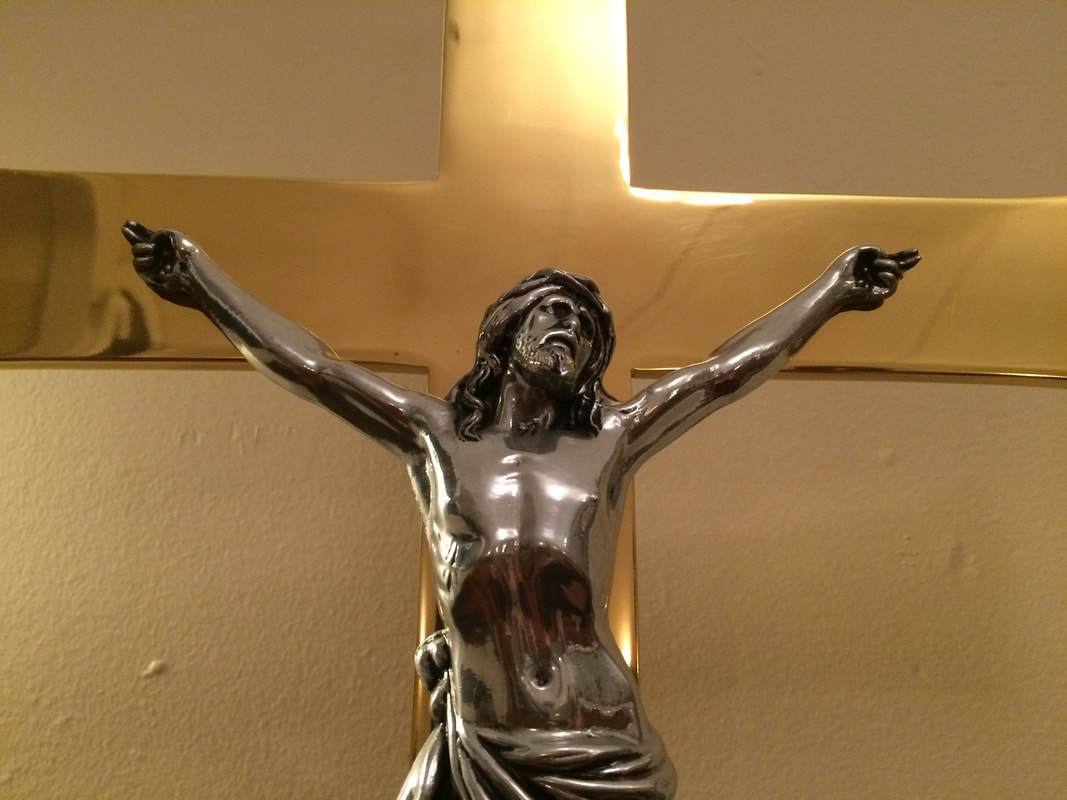|
Scripture Readings: Numbers 21:4–9 | Psalm 107:1–3, 17–22 | Ephesians 2:1–10 | John 3:14–21
And just as Moses lifted up the serpent in the wilderness, so must the Son of Man be lifted up, that whoever believes in him may have eternal life. (John 3:14) What comes to our minds when we look at a cross? For many, crosses are simply a common Christian symbol… an image closely identified with one of the world’s religions. With a bit more reflection, of course, crosses become a lot more uncomfortable. Long before Christianity, crosses were simply instruments of death… a form of brutal execution, designed to cause all sorts of suffering, as well as to publicly display the powerlessness of the victim, all while showcasing the supremacy of those who had them lifted up. This tension isn’t erased when we turn to the story of Jesus either, for the crucifixion of Jesus exposes the worst of what’s wrong with the world: as this upright, innocent man is betrayed, /and handed over to humiliation, suffering, and a cruel death in an absolutely atrocious act of injustice. And yet… from the very beginning, Christians have looked back on the cross as absolutely central to the Good News of God, seeing it as the focal point of genuine forgiveness, and the indispensable pillar holding up all of our hope. The season of Lent lays before us the road to the cross, and it calls us to contemplate its deeper significance. And so today, the fourth Sunday of Lent, we’re drawn towards an odd passage from the Book of Numbers (or as it’s known in Hebrew: In the Wilderness), a story about doubt, deadly snakes, and a curious cure… a story picked up by Jesus Himself to point us to His purpose: to shed much needed light upon His mission of redemption. The story takes place in the wilderness, as the people of Israel are being lead by God through Moses from slavery in Egypt into a whole new life, and new land of their own. At this point, they’ve already spent years travelling in the desert, consistently provided for by the gracious hand of God. And yet, they consistently prove themselves to be quick to turn on the LORD… exposing their lack of trust in His love for them, and betraying Him in their hearts every time they find themselves in trouble. “Why have you brought us up out of Egypt to die in the wilderness?” we heard them say today, “For there is no food and no water, and we detest this miserable food.” (Numbers 21:5). The scholar Elizabeth Achtemeier sums up their reaction like this: “Absent is any recollection of their gracious deliverance by the hand of God. Gone are all thoughts of the covenant they have entered into with the Lord at Mount Sinai. Forgotten is the divine promise that they are to be God’s chosen, holy nation and a kingdom of priests. Their present discomfort and suffering rob them of the memory of God’s gracious redemption and faithful day-and-night guidance of them.”[1] And so, in the face of Israel’s persistent unfaithfulness, serpents are sent, bringing to light the people’s sin… with dire consequences. In this case at least, the people’s suffering seems to bring them to their senses. In Numbers 21:7 we’re told they “came to Moses and said, “We have sinned by speaking against the Lord and against you; pray to the Lord to take away the serpents from us.” (Numbers 21:7). In response to their repentance, the LORD doesn’t remove the deadly serpents, but He does mercifully provide their means of survival… one which requires those bitten to respond with trust in God. “And the Lord said to Moses, “Make a poisonous serpent, and set it on a pole; and everyone who is bitten shall look at it and live.” So Moses made a serpent of bronze, and put it upon a pole; and whenever a serpent bit someone, that person would look at the serpent of bronze and live.” (Numbers 21:8-9) How was that supposed to work?!? The story doesn’t care about unpacking the mechanics of the miracle. In many ways, it remains a strange story for us today. But there are a few points that this part of Israel’s story raises for us to ponder: First, God’s people had turned away from Him in distrust and ungratefulness, bringing about their own suffering and death as a result. Yet God provided for them a sign which brought about salvation: despite their betrayal, they would live if they trusted in the LORD’s gift… if they looked on the serpent of bronze, which was raised up to rescue them. Turning now to the Gospel of John, we hear Jesus draw this odd episode from Israel’s past into His own unfolding story, in the context of a conversation with one of the teachers of Judah. In John chapter 3, were told that a pharisee named Nicodemus came one night seeking to speak with Jesus. A risky move, considering that by this point, our Lord was already becoming a controversial figure. But Nicodemus seems open to what Jesus was up to. “Rabbi,” he says, “we know that you are a teacher who has come from God; for no one can do these signs that you do apart from the presence of God.” (John 3:2). Nicodemus acknowledges that Jesus was sent from the Living God, the same LORD who had rescued Israel from Egypt centuries earlier, and had led them through the wilderness and into the Promised Land. He sees at work in Jesus the holy presence of God… but our Lord takes this conversation in a surprising direction. “Jesus answered him, “Very truly, I tell you, no one can see the kingdom of God without being born from above.” (John 3:3) What follows is a back and forth between Jesus and a puzzled Nicodemus, where it becomes clear that our Jesus is presenting Himself as more than a godly teacher, but as the One sent with the unique role of revealing God work in the world. “No one has ascended into heaven” He says, “except the one who descended from heaven, the Son of Man.” And just as Moses lifted up the serpent in the wilderness, so must the Son of Man be lifted up, that whoever believes in him may have eternal life.” (John 3:13-15) If you blink, you’ll miss it. Just one line thrown into a complicated, multilayered exchange. But by referencing this ancient story of doubts, and snakes, and salvation, Jesus is shedding important light on what He claims He has come to do… comparing Israel’s unfaithfulness in the wilderness to the situation in Nicodemus’ day… and in our own! Just as in the wilderness, long ago, where Israel had turned their back on the LORD, doubting His faithfulness, forgetting His gracious deliverance and covenant with them, grumbling against His provisions, and despising the path He was leading them on, Jesus was making the case that God’s people were again betraying the LORD, and so were headed for disaster. The leadership of God’s people at the time of Nicodemus had claimed to be concerned with being faithful to the LORD, obeying His covenant, and walking in His ways. Yet time and again their response to Jesus’ actions and words exposed their hardened hearts, towards God and their neighbours. They had become preoccupied with their own preservation, instead of pursuing their calling to be God’s people in the world. It was as if they were reliving their ancestor’s unfaithfulness in the wilderness: preferring the darkness of hypocrisy, selfishness, and pride to the light of the LORD… and by evoking this story, Christ was exposing the sin of His people. Not just in Jerusalem that day, but in our day and age as well. How have we relived the sins of Israel in the wilderness? How have we re-enacted the same distrust, ungratefulness, and contempt of God’s holy ways in our own lives? Perhaps paying lip service to the commandments of God, while happy to hide much of our heart’s desires in the dark? This isn’t easy to think about. It’s even harder to talk about. It’s so much more comfortable to turn a blind eye to our darkness… instead of stepping into the light so that it can all be dealt with. But just as Israel’s guilt, in the wilderness, and in Nicodemus’ day, was only the beginning and not the end of the story, our own failures and sinfulness don’t have the final say either. We too are offered hope and forgiveness from the LORD, as Christ reveals God’s merciful response to all our unfaithfulness. As He did long ago in the wilderness, God has provided a saving gift, only this one was meant not for one betrayal, but for all betrayals… not for one moment in history, but for all of time… not only for one people, but for all the families of the earth… offering new life to any and all who look at the Christ, the Son of Man ‘lifted up’ on the cross, and see in Him, in His suffering and death, God’s unending love for sinners… and place their trust, no longer in themselves, but in Him. “And just as Moses lifted up the serpent in the wilderness, so must the Son of Man be lifted up, that whoever believes in him may have eternal life. For God so loved the world that he gave his only Son, so that everyone who believes in him may not perish but may have eternal life. Indeed, God did not send the Son into the world to condemn the world, but in order that the world might be saved through him.” (John 3:14-17) In connecting His mission with the story from Numbers Chapter 21, Jesus was not simply exposing the darkness at work in all of our lives… He is pointing us to the remedy for our spiritual sicknesses: that is, His own life, lifted up on the cross, and offered as a gift of love from God to our messed up world. As one scholar puts it: “Like the dying Israelites looking to the snake “lifted up” for healing, we are to see in Jesus’ broken body “lifted up” on an instrument of torture our healing and the source of eternal life.”[2] For the Israelites in the wilderness, looking at the bronze snake, would no doubt be deeply uncomfortable: a clear reminder that they had brought about their own misery. But if they responded to the invitation to look at it anyway, trusting in God’s mercy, it was transformed from a reminder of suffering, sin, and death into a gift meant to ensure their survival. For you and I, looking at Jesus on the cross, we are forced to remember the reasons for His suffering: our sin, but ultimately God’s love. We are invited to look at Jesus lifted up on the cross and see much more than the brutal result of human betrayal and unfaithfulness… we’re invited to see the merciful love of the Living God for sinners like us, and looking at Him in faith, we are offered forgiveness, reconciliation, and God’s everlasting life, which we now know that even the grave itself is powerless to stop. Jesus endured the cross for us as an act of God’s saving love. His whole mission was not to condemn, but to offer us His life, once and for all. As we draw nearer to Holy Week, to the suffering of Christ on the cross, may we remember that, for us, it is always a sign of God’s great love: drawing us out of the darkness and into God’s life-giving light, where everyone can find forgiveness, healing, and hope. Amen. [1] Elizabeth Achtemeier, “Fourth Sunday in Lent, Year B,” in The Lectionary Commentary: Theological Exegesis for Sunday’s Texts, Volume One (Grand Rapids, MI: Eerdmans, 2001), 120–121. [2] Richard A. Burridge, “Fourth Sunday in Lent, Year B,” in The Lectionary Commentary: Theological Exegesis for Sunday’s Texts, Volume Three, ed. Roger E. Van Harn (Grand Rapids, MI: Eerdmans, 2001), 500.
0 Comments
Your comment will be posted after it is approved.
Leave a Reply. |
Rev. RObRev. Rob serves as the Priest-in-Charge at St. Luke's Gondola Point, and as the School Chaplain at Rothesay Netherwood School Archives
June 2024
Categories
All
|
|
5 Quispamsis Road, Quispamsis NB, E2E 1M2
Mail to: 12 Quispamsis Road, Quispamsis NB E2E 1M2 |
Contact Us
Parish Phone: 506-847-3670 | www.stlukesgp.ca | www.facebook.com/StLukesGP/ Rev. Rob: 506-608-1772 | [email protected] |
Proudly powered by Weebly


 RSS Feed
RSS Feed
